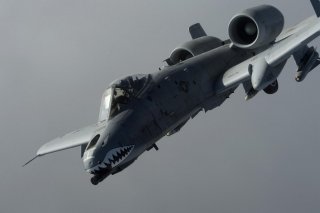The A-10 Warthog Is Getting New Wings
Though the platform excelled against ground targets in the Middle East, it is unlikely to survive against peer threats.
Boeing is re-winging the United States Air Force A-10 Thunderbolt II fleet in partnership with Korean Aerospace Industries and other suppliers.
"Boeing is working diligently to deliver greatly needed new wings for the A-10 fleet," said Lt. Col. Jaclyn Melton, the materiel leader for A-10 Programs at Hill Air Force Base.
The statement explains that Boeing was awarded the contract in “August 2019 and is currently working to provide the Air Force with 50 wing sets. Each wing set consists of outer wing assemblies, center wing assembly, control surfaces and the fuselage integration kit. The upgraded wings are more durable, efficient, and easier to maintain, extending A-10 flying life to 10,000 hours.”
“The A-10 serves a critical role for the Air Force and Boeing is proud to extend our legacy of supporting the Thunderbolt and its mission,” said Dan Gillian, vice president of U.S. Government Services for Boeing Global Services.
“In partnership with the Air Force and our established supply base, we have started full rate production and are actively supporting the customer’s installation schedule.”
The A-10’s production line has been closed, “with tools and equipment housed in long-term storage.” But Boeing Global Services “revived the tooling and activated the supply base within 12 months of contract award,” the company explained, adding that their “previous experience with the A-10 includes delivering 173 enhanced A-10 wing assemblies under a separate contract.”
Although the United States’ A-10s are getting new sets of wings that will significantly extend their service lives, the fleet as a whole does not have much life left in it. A Cold War-era ground-attack and close-air-support aircraft, the A-10 is well-suited to engaging ground targets in uncontested airspace.
However, in contested airspace—the kind of airspace the Air Force could expect to encounter in a peer conflict against China or Russia—the A-10 would struggle.
The U.S. Air Force justifies pushing the A-10 out of service because of its low survivability. Maintaining the platform pulls resources that the Air Force could instead put into other aerial platforms like the F-35 or the Next-Generation Air Dominance fighter, a sixth generation aircraft that the Air Force currently has in development.
Although the A-10 has managed to scoot off the U.S. Air Force chopping block several times before, it seems unlikely that it will be able to survive the axe for much longer. More sophisticated anti-air defenses and a pair of concerted peer enemies may ultimately doom the flying tank-buster.
Caleb Larson is a multimedia journalist and defense writer with the National Interest. A graduate of UCLA, he also holds a Master of Public Policy and lives in Berlin. He covers the intersection of conflict, security, and technology, focusing on American foreign policy, European security, and German society for both print and radio. Follow him on Twitter @calebmlarson.
Image: Flickr/U.S. Air Force.

